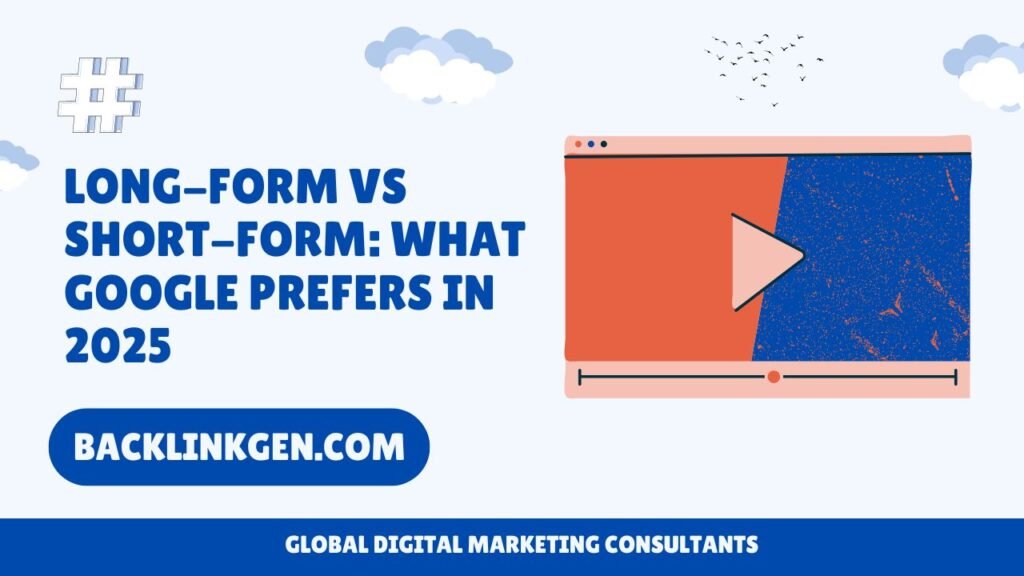Insights from Backlinkgen.com, your global SEO partner
For years, marketers have debated:
“Should I write long, detailed articles — or quick, short posts?”
In 2025, Google’s evolving algorithms — combined with changing user behavior and the rise of AI-generated content — have reshaped the answer.
At Backlinkgen, we work with brands in the U.S., Europe, Asia, and beyond. Here’s what the data and real-world campaigns show about what actually works today — and why the right choice isn’t always obvious.
🧠 What’s Considered Long-Form vs Short-Form?
| Type | Typical Word Count |
|---|---|
| Short-Form | Under 800–1,000 words |
| Long-Form | 1,500–3,000+ words |
But remember: word count alone doesn’t guarantee rankings. It’s about content depth and user intent.
📊 What Google’s Algorithm Really Wants in 2025
Google’s recent updates — especially the Helpful Content Update and advances in AI ranking systems — prioritize:
✅ Content that fully answers the searcher’s question
✅ Topical depth & authority
✅ Clear structure (H2s, H3s, bullet points)
✅ Original insights or data
✅ Good UX: mobile-friendly, scannable, fast-loading
Google doesn’t have a fixed “word count preference.” It ranks content that best solves the query.
📝 When Long-Form Wins
Long-form content (1,500–3,000+ words) still outperforms when:
✔ Users want in-depth guidance
✔ Keywords have high competition
✔ Content includes data, examples, case studies, and visuals
✔ You need to build topic authority with pillar pages
Examples:
- “Ultimate Guide to B2B SEO”
- “Complete Checklist for Website Migration”
- “Top 25 Marketing Trends with Data & Expert Quotes”
Long-form content also attracts more backlinks, as it’s seen as a comprehensive resource.
⚡ When Short-Form Wins
Short-form content shines when:
✔ Users want quick answers (often from mobile)
✔ Topic is narrow or tactical
✔ You’re targeting low competition, long-tail keywords
✔ Speed and clarity matter more than depth
Examples:
- “How to Add a User in WordPress (2025)”
- “What is a CTA?”
- Quick industry news updates
Short posts are also great for content refreshes, social sharing, and voice search optimization.
🌍 Global SEO Insight: Content Length by Market
At Backlinkgen, we see regional differences:
| Region | Users Prefer | Why |
|---|---|---|
| US & UK | Long-form + detailed data | High competition, advanced audiences |
| Asia (India, Singapore) | Mix | Users want depth, but mobile speed matters |
| Europe (Germany, France) | Authoritative, research-backed long-form | Trusted sources perform better |
Localization matters more than length: local examples, stats, and references outperform generic text — even if it’s long.
🧩 Best Practice: Focus on Intent, Then Format
1️⃣ Start with search intent:
- Are users comparing products, learning deeply, or just need a definition?
2️⃣ Map the right format:
- Pillar page? Blog post? FAQ? Video summary?
3️⃣ Optimize for usability:
- Use subheadings, images, internal links, and clear CTAs.
4️⃣ Refresh regularly:
- Update long-form guides annually; short posts as trends change.
📈 The Hybrid Approach for 2025
The highest-performing strategy we see at Backlinkgen combines both:
- Long-form pillar content that builds topical authority and ranks for head terms
- Short-form support posts that target long-tail queries and feed traffic to the pillar page
This approach also improves:
✅ Internal linking
✅ Dwell time
✅ Total organic visibility
🚀 Final Thoughts: Quality > Quantity, Depth > Length
In 2025, Google doesn’t “prefer” long or short content.
Google prefers content that solves user problems better than anyone else.
At Backlinkgen.com, our MNC-led SEO teams help brands:
✅ Map content length to search intent
✅ Localize for international audiences
✅ Blend data, design, and storytelling for engagement
✨ Want a content strategy built for modern search?
👉 Book a call with Backlinkgen and let’s align your content with what Google — and your audience — really wants.

